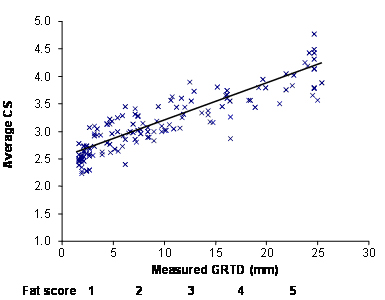
The
relationship
between
measured
GRTD
on
the
carcass
and
the
average
condition
score
(CS)
assessed
by
4
skilled
assessors
for
adult
fine
and
medium
merino
ewes
and
adult
merino
border
leister
ewes
In
the
range
of
GRTD>5mm
every
5mm
increase
in
GRTD
(i.e.
each
increase
of
one
fat
score)
corresponded
to
a
0.3
increase
in
condition
score
in
both
experiments.
However,
for
flocks
being
managed
around
an
average
condition
score
target
of
2.5
or
below,
it
can
be
argued
that
condition
score
is
the
superior
measure
as
over
half
the
sheep
in
the
flock
would
be
assessed
as
fat
score
one.
Ewes
with
a
condition
score
of
2
to
2.5
represent
healthy
sheep
in
'store'
condition
that
are
commercial
reality
in
many
flocks
in
late
summer
or
mid
lactation.
Converting
between
Fat
Score
and
Condition
Score
A
regression
of
the
average
fat
score
(4
operators)
and
average
condition
score
(4
operators)
from
the
NSW
experiment
gives
the
conversion
equation
Condition
score
=1.93+0.102*GRTD
(R-squared=88%).
While
this
equation
may
be
our
best
available
option
for
now,
it
is
important
to
be
aware
of
the
errors
introduced
when
using
it
for
converting
between
fat
score
and
condition
score
in
general.
Since
the
Average
condition
score
and
Average
fat
score
are
based
on
4
operators
at
a
given
time
and
location,
both
could
have
some
bias.
The
errors
would
also
vary
depending
on
the
bias
of
the
operator
whose
scores
are
being
converted.
There
is
also
the
question
of
whether
one
should
convert
to
the
average
fat
score
(estimated
GRTD)
or
whether
one
should
convert
to
actual
GRTD.
In
the
latter
case
the
conversion
equation
becomes
Condition
score
=2.49+0.060*GRTD
(based
on
the
data
from
the
NSW
'medium
merino'
and
'first
X'
groups).
The
table
below
shows
the
conversion
of
fat
score
=1,
2,
3
and
4
under
different
scenarios.